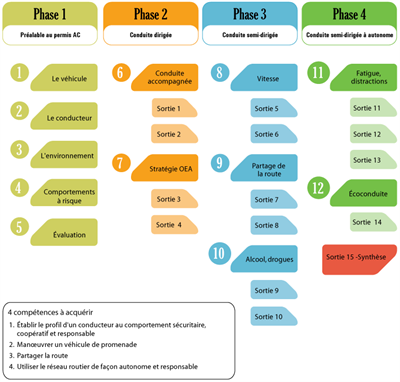
PRESENTING THE DRIVING COURSE
The passenger vehicle driving course, entitled the Road Safety Education Program, was developed using a competency-based approach.
The course aims for learners to acquire the following competencies:
Establishing the profile of a safe, cooperative and responsible driver
Handling a passenger vehicle
Sharing the road
Using the road network independently and responsibly
The program is divided into 12 modules that alternate between classroom learning, self-study and on-road instruction. This alternating approach lets learners put the knowledge and competencies acquired in the classroom and from self-study into practice during the in-car sessions. This formula also promotes better integration of the knowledge, skills and behaviour covered in the course.
The course's 12 modules are grouped together into 4 phases:
Phase 1, which is the prerequisite for a learner's licence and includes Modules 1 to 5
Phase 2, which includes Modules 6 and 7, during which learners undertake their first guided driving sessions on the road
Phase 3, which includes Modules 8 to 10, during which learners undertake semi-guided outings on the road
Phase 4, which includes Modules 11 and 12, during which learners undertake increasingly independent driving on the road
This image shows the distribution of the course modules, their titles and the related in-car sessions.
THEORETICAL TRAINING
The theoretical training includes both classroom learning and self-study. Each module includes 2 hours of classroom training during which instructors encourage thought and awareness through educational activities related to the concepts covered in the module in question. Instructors evaluate the learners' acquisition of knowledge and competencies at several stages in the theoretical training throughout the entire course.
PRACTICAL TRAINING
The practical training is composed of 15 in-car sessions, each of which lasts approximately 1 hour. Before each session, instructors discuss the manoeuvres learners will have to perform and the behaviours they will be required to adopt. At the end of each session, learners fill out a self-evaluation form and talk to their instructor about their strengths, what they can improve upon and what they should practice in subsequent in-car sessions. Practical training evaluations are carried out by the instructors during in-car sessions 5, 10 and 15, the latter being the summary session before the SAAQ road test.
THEORETICAL EVALUATIONS
After completing the first 4 modules, learners undergo the first theoretical evaluation in the form of a written test. This test, which assesses the learners' knowledge of the theory covered so far, was designed by the SAAQ and is administered by the driving school. Passing this test allows learners to obtain their learner's licence.
At least 10 months after obtaining their learner's licence, learners must pass a knowledge test at an SAAQ service centre. It is recommended that learners take this test once they have seen all of the course's theoretical content, namely all 12 modules. They must make an appointment to take this test.
ROAD TEST
Twelve months after obtaining their learner's licence, learners who have passed the SAAQ knowledge test and received an attestation confirming that they successfully completed the driving course can go to an SAAQ service centre to take the road test. It is very important that they make an appointment to take this test.
DOCUMENTS USED DURING THE COURSE
PowerPoint presentations: Presentation of the course
Classroom Activity Workbook
In-Car Session Workbook
MANOEUVRES AND BEHAVIOURS
Presentation that includes 14 video clips, that is, 1 sclip for each in-car session. Viewing these clips allows learners to recognize the right and wrong behaviours to adopt in various driving situations and to apply the OEA (Observe – Evaluate – Act) strategy. At the end of a classroom theoretical module, instructors can take a few minutes to present the video clip for the in-car session associated with the module. If the video-clip cannot be viewed in the classroom, learners are encouraged to view the video clip at another time, by referring to the presentation.
PowerPoint presentation: Manoeuvres and Behaviours